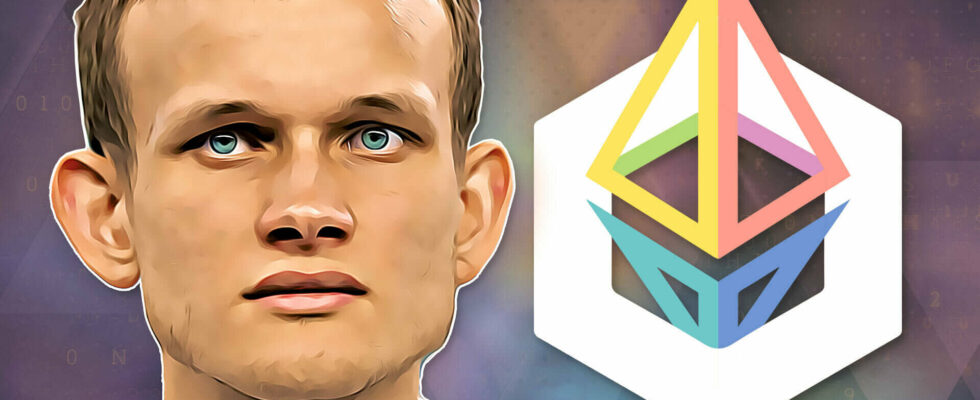Account abstraction on Layer 2 – Vitalik Buterin frequently shares his thoughts on the changing ecosystem ofEthereum. Recently, he presented the 3 major evolutions that Ethereum will have to go through to become a major technology. On this occasion, he notably highlighted the use of Layer 2 (L2) and smart contract wallets.
Now Buterin is back with an article detailing how L2s and wallets should evolve together for the benefit of users.
Layer 2 and account abstraction
Before getting to the heart of the matter, it is worth remembering what a Layer 2 as well as account abstraction.
On the one hand, a Layer 2 or second layer solution, is a secondary blockchain that evolves “on top” of a blockchain. For example, Arbitrum, Optimism or Starknet are L2s of Ethereum.
Its purpose is to offer an ecosystem similar to that of the underlying channel. All this while offering better performance in terms of transaction speed and reducing costs.
These solutions are central to the development of Ethereum. In fact, they have been put center of the network roadmap for the coming years.
Account abstraction, on the other hand, is a concept that aims to make accounts more flexible. This involves moving to a smart contract wallets. It is a wallet that will take the form of a smart contract deployed on a blockchain.
These wallets offer various advanced features. We can cite the key recovery, scheduled transactions, daily spending limits and more. Moreover, they allow a total abstraction of the concept of seed phrase for the user.
Nevertheless, smart contract wallets do not do not allow you to keep a single address. Unlike addresses owned by external users, such as those used on MetaMask, a smart contract wallet lives only on the chain where it was deployed.
Therefore, it becomes more difficult to maintain a single address on the L1 and the different L2s. This also makes communications between the different Layer 2s more complicated.
As expressed on several occasions, Vitalik Buterin considers that smart contract wallets will be necessary to promote adoption.
>> If earning 1 bitcoin does not interest you, do not click on this link (commercial link) <<
The challenge of inter-L2 reading
When it comes to smart contract wallets, cross-L2 reading takes on a whole new dimension. Indeed, these wallets are hosted on a given channel. It can be an L1 or a second layer solution. Therefore, this means that they are limited in their ability to access information on other channels. Indeed, smart contracts can only access the information available on their blockchain. So far, external information is transmitted to them via oracles.
In addition, each L2 has its own way of managing data and transactionswhich makes communication between different L2 solutions complex.
For example, if you have funds in a smart contract wallet on one L2, how can another L2 or your wallet on L1 determine how much you have? Also, if you want to send money from one L2 to another, how can this be done efficiently and securely?
This is not just about allowing smart contract wallets to “see” across multiple chains, but also to facilitate cross-chain transactions.
Vitalik’s Solution
To overcome this problem, Vitalik Buterin imagined a new architecture. This would allow wallets to read and interact with multiple L2 solutions. Thus, he introduces the concept of “keyring contract” and of “portfolio contracts”.
On one side, the “keyring contract” is a contract that stores verification key for all wallets of a user as well as the rules for changing the key.
On the other, the “portfolio contracts”on the other hand, are contracts on L1 or L2, which read the cross-chain information to get the verification key.
Put simply, this means that your wallet might be able to interact with your assets on different L2 solutions without having to constantly switch RPCs or perform other technical manipulations.
The advantages of the Vitalik solution
The solution proposed by Vitalik Buterin offers several advantages. First, it could allow a better integration between different L2 solutionsthereby facilitating cross-chain transactions.
Moreover, Buterin’s proposal could make the use of blockchain more affordable for novice users. Indeed, as we have seen previously, these wallets are used without complex technical manipulations. In addition, they have many features that improve the security of funds.
However, implementing Vitalik Buterin’s solution will not be an easy task. For example, each L2 has its own way of handling data and transactions, which makes communication between different L2 solutions complex. Especially since no standard has been put in place.
In addition, the transition to smart contract wallets requires profound changes in applications and wallets, which requires significant coordination.
When announcing its publication on Twitter, Vitalik Buterin affirmed its desire to standardize this type of communication on Ethereum. As a result, all of the L2s could communicate with each other without having to make adjustments on a case-by-case basis.
In parallel, Ethereum developers are working on the development of the Cancun update. This will primarily focus on Proto-Danksharding, a new type of transaction that will drastically reduce transaction costs on L2s.
The regulation mistreats your cryptocurrencies? Register quickly on Binance THE reference crypto platform, to try to win the game and add 1 bitcoin to your portfolio. What do you decide? (commercial link)

